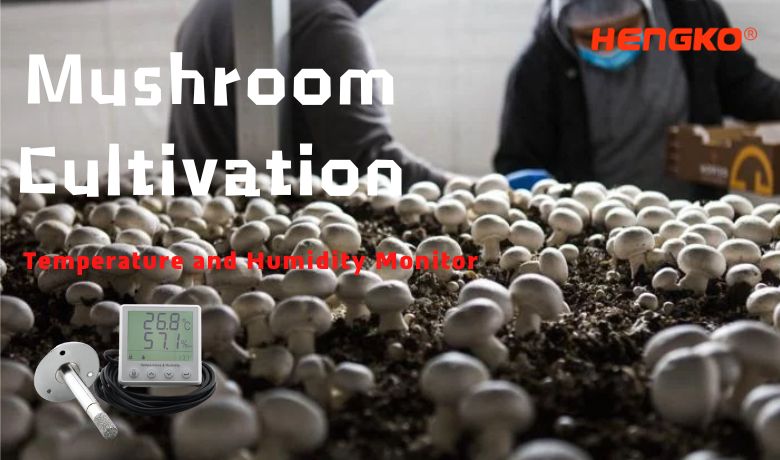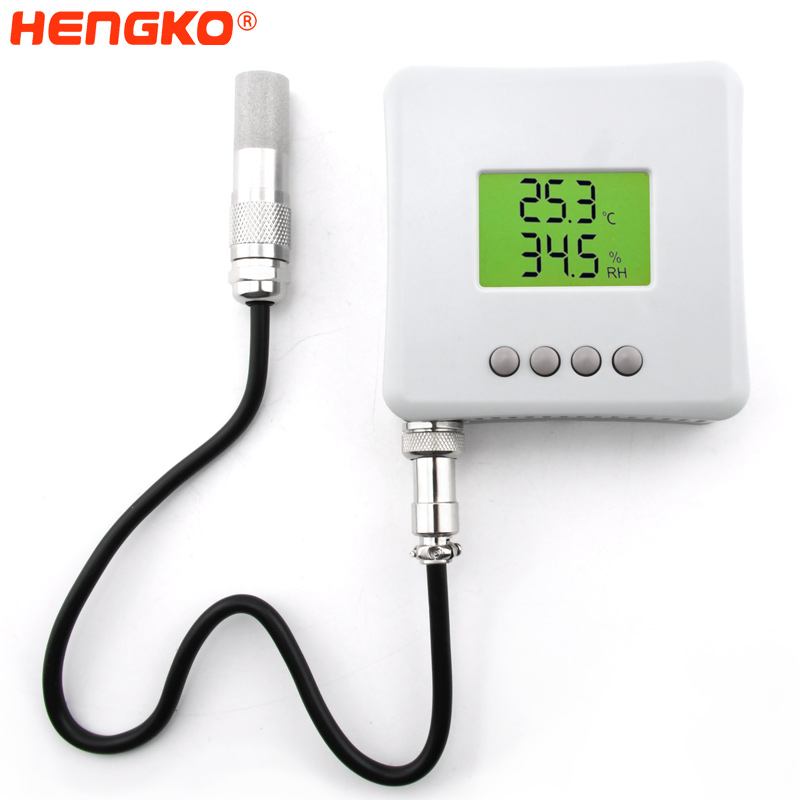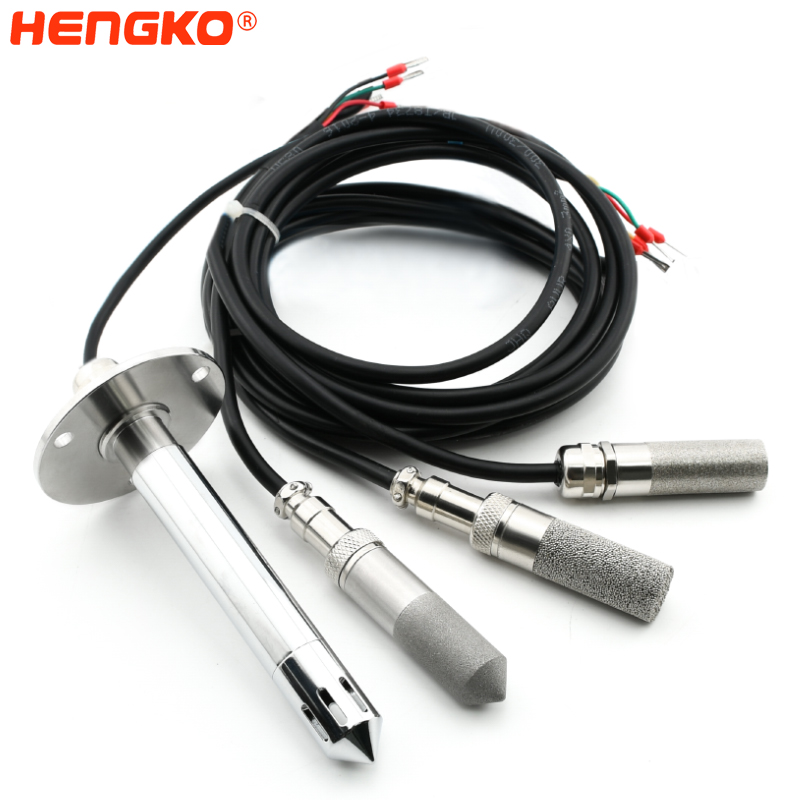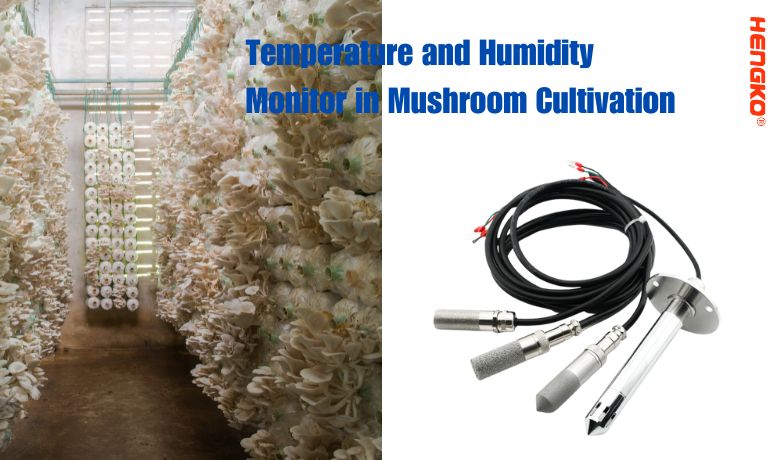
Temperature and Humidity Monitor in Mushroom Cultivation ?
Mushroom growers will say that all you need is a dark room to grow mushrooms, but temperature and humidity play the main role in whether mushrooms will put forth a fruiting body. Compost that is not finished will certainly produce too much heat for a button mushroom and will kill the mycelium.
The water content of mushrooms is very high, and about 90% of the fungus is water. High humidity conditions are very good growth conditions for fungi. For temperature and humidity sensors, however, high humidity (> 95 % RH) environments and contamination from released fungal spores and fungal hyphae (mycelium) are more difficult challenges. Therefore, both temperature and humidity sensors and gas sensors for industrial mushroom cultivation must be resistant to contamination and at the same time measure accurately and reliably under high humidity conditions.
It is difficult to operate for humidity sensor in the high temperature. HENGKO temperature and humidity sensor adopts waterproof humidity sensor shell and it will keep water from seeping into the body of the sensor and damaging it, but allows air to pass through so that it can measure the humidity (moisture) of the environment.
Mushrooms take in a lot of oxygen as they grow and release carbon dioxide. Mushroom factories are mostly closed workshops, and if carbon dioxide levels are too high, mushroom growth will be affected. Therefore, in the actual cultivation of mushrooms, carbon dioxide sensors should be installed to measure the concentration of carbon dioxide. If the concentration exceeds the standard, ventilation can be carried out or timely treatment.
How to control humidity in mushroom farm ?
Controlling humidity in a mushroom farm is crucial for successful cultivation. Here are some methods commonly used to maintain optimal humidity levels:
1. Misting and Spraying:
Regular misting or spraying of water in the growing area helps increase humidity. This can be done manually using handheld sprayers or automated systems that release water at predetermined intervals. It is important to distribute the water evenly to avoid excessive moisture in specific areas.
2. Ventilation and Air Exchange:
Proper ventilation plays a significant role in regulating humidity. By controlling the airflow and exchanging stale air with fresh air, you can prevent excessive humidity buildup. Ventilation systems equipped with fans and air vents help remove excess moisture and maintain a balanced humidity level.
3. Humidifiers:
Humidifiers are devices specifically designed to increase humidity levels. They work by releasing moisture into the air, helping to maintain the desired humidity range. Different types of humidifiers, such as ultrasonic, evaporative, or steam humidifiers, can be used based on the farm's size and specific requirements.
4. Substrate and Water Management:
Proper substrate moisture management is essential for maintaining humidity. Mushroom beds or substrates need to be adequately hydrated and monitored to prevent drying out or becoming too wet. Regular watering or misting of the substrate helps maintain the desired moisture content.
5. Humidity Monitoring and Control Systems:
Installing humidity monitoring and control systems can automate the process of maintaining the ideal humidity range. These systems use sensors to measure humidity levels and adjust the misting, ventilation, or humidifier operations accordingly. They ensure precise control and provide real-time monitoring of humidity conditions.
6. Insulation and Enclosure:
Proper insulation of the mushroom farm helps retain moisture and control humidity levels. Ensuring that the growing area is properly enclosed and insulated minimizes the impact of external factors on humidity, such as ambient air conditions or airflow from outside.
It is important to note that different mushroom species may have specific humidity requirements. Understanding the specific needs of the cultivated mushroom variety and adjusting the humidity control methods accordingly is crucial for successful cultivation. Regular monitoring of humidity levels and making necessary adjustments based on the growth stage of the mushrooms is essential to ensure optimal conditions for growth and yield.
What Factors You Should Care When do Monitor the Temperature and Humidity Monitor in Mushroom Cultivation ?
If You monitoring temperature and humidity in mushroom cultivation, several factors should be considered to ensure optimal conditions for growth. These factors include:
1. Temperature Range:
Different mushroom species have specific temperature preferences for growth. It is crucial to monitor and maintain the temperature within the recommended range for the particular mushroom variety being cultivated. Sudden temperature fluctuations or prolonged exposure to extreme temperatures can negatively impact mushroom growth and yield.
2. Relative Humidity:
Mushrooms thrive in environments with specific humidity levels. Monitoring and controlling relative humidity is essential to create the ideal microclimate for mushroom cultivation. Maintaining humidity within the recommended range helps promote proper fruiting, prevent drying out or excessive moisture, and minimize the risk of fungal diseases.
3. Air Exchange:
Proper air circulation and exchange are important for controlling temperature and humidity. Stagnant air can lead to increased humidity, CO2 buildup, and decreased oxygen levels, which are unfavorable for mushroom growth. Monitoring and ensuring adequate air exchange helps maintain a fresh and oxygen-rich environment.
4. Growth Stage:
The temperature and humidity requirements of mushrooms can vary depending on their growth stage. For example, the initial colonization phase may require higher humidity levels, while fruiting or mushroom formation stages may require specific temperature and humidity adjustments. It is essential to monitor and adjust the conditions accordingly as the mushrooms progress through different growth stages.
5. Ventilation:
Proper ventilation plays a vital role in maintaining temperature and humidity levels. It helps remove excess heat, regulate humidity, and replenish fresh air. Monitoring ventilation systems, such as fans or air vents, ensures efficient airflow and prevents the accumulation of stagnant air or excessive moisture.
6. Seasonal Variations:
Seasonal changes can significantly affect temperature and humidity in mushroom cultivation. Outdoor temperature fluctuations and varying humidity levels can impact indoor growing environments. Monitoring these variations and making necessary adjustments, such as insulation or climate control systems, helps compensate for seasonal changes and maintain consistent growing conditions.
Regular monitoring of temperature and humidity, along with timely adjustments, allows growers to create a favorable environment for mushroom cultivation. By maintaining optimal conditions, it promotes healthy growth, reduces the risk of diseases, and maximizes the yield and quality of the harvested mushrooms.
Can you please introduce some humidity control system for mushroom growing ?
Certainly! Here are a few humidity control systems commonly used in mushroom growing:
-
Automated Mist and Fog Systems: These systems utilize timers or sensors to automate the release of fine mist or fog into the growing environment. They help maintain the desired humidity levels by periodically providing a controlled amount of moisture. Automated mist and fog systems ensure consistent and efficient humidity control, especially in larger mushroom growing operations.
-
Humidifiers: Humidifiers are devices specifically designed to increase humidity levels in an enclosed space. They release moisture into the air, helping to maintain the desired humidity range. Different types of humidifiers, such as ultrasonic, evaporative, or steam humidifiers, can be used based on the farm's size and specific requirements. Humidifiers are often used in conjunction with humidity controllers to regulate moisture levels accurately.
-
Ventilation and Air Exchange Systems: Proper ventilation is crucial for controlling humidity in mushroom growing. Ventilation systems equipped with fans and air vents help remove excess moisture and ensure proper air exchange. By allowing the stale air to be replaced with fresh air, these systems prevent the buildup of excess humidity and maintain a balanced growing environment.
-
Dehumidifiers: In some cases, mushroom farms may experience excessive humidity levels due to external factors or high ambient moisture. Dehumidifiers are used to remove excess moisture from the air and regulate humidity levels. They are especially beneficial in regions with high humidity or during certain seasons when humidity control becomes challenging.
-
Insulation and Enclosure: Proper insulation of the growing area helps retain moisture and control humidity levels. Ensuring that the mushroom farm is properly enclosed and insulated minimizes the impact of external factors on humidity, such as ambient air conditions or airflow from outside. Well-insulated growing rooms help maintain a stable and controlled environment, reducing the need for excessive humidity control measures.
It is important to assess the specific needs of your mushroom cultivation setup and consult with experts or suppliers to determine the most suitable humidity control system for your farm.
So, if you have do Mushroom Cultivation, you can try our Temperature and Humidity Monitor, believe you will get more and Better Mushroom.
Have any other questions, please feel free to contact us by email ka@hengko.com, also you can go to our contact us page to send inquiry by the from.
Post time: Jan-20-2022








